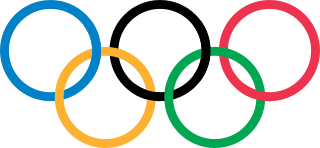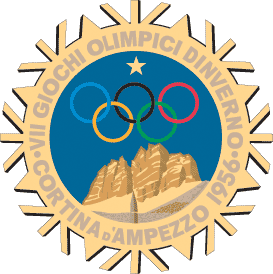
The Winter Olympic Games is a major international multi-sport event held once every four years for sports practiced on snow and ice. The first Winter Olympic Games, the 1924 Winter Olympics, were held in Chamonix, France. The modern Olympic Games were inspired by the ancient Olympic Games, which were held in Olympia, Greece, from the 8th century BC to the 4th century AD. Baron Pierre de Coubertin founded the International Olympic Committee (IOC) in 1894, leading to the first modern Summer Olympic Games in Athens, Greece in 1896. The IOC is the governing body of the Olympic Movement, with the Olympic Charter defining its structure and authority.

The 1952 Winter Olympics, officially known as the VI Olympic Winter Games and commonly known as Oslo 1952, was a winter multi-sport event held from 14 to 25 February 1952 in Oslo, the capital of Norway.

The 1960 Winter Olympics were a winter multi-sport event held from February 18 to 28, 1960, at the Squaw Valley Resort in Squaw Valley, California, United States. The resort was chosen to host the Games at the 1956 meeting of the International Olympic Committee (IOC). Squaw Valley was an undeveloped resort in 1955, so the infrastructure and all of the venues were built between 1956 and 1960 at a cost of US$80,000,000. The layout was designed to be intimate, allowing spectators and competitors to reach most of the venues on foot.

The 1956 Winter Olympics, officially known as the VII Olympic Winter Games and commonly known as Cortina d'Ampezzo 1956, was a multi-sport event held in Cortina d'Ampezzo, Italy, from 26 January to 5 February 1956.
The 1968 Winter Olympics, officially known as the X Olympic Winter Games, was a winter multi-sport event held in Grenoble, France, from 6 to 18 February 1968. A total of 1,158 athletes representing 37 National Olympic Committees (NOCs)—including Morocco's first delegation—participated in 35 events from 10 different sports and disciplines. The team relay (4 × 7.5 km) event in biathlon was contested for the first time.
The 1952 Winter Olympics, officially known as the VI Olympic Winter Games, took place in Oslo, Norway, from 14 to 25 February 1952. A total of 694 athletes representing 30 National Olympic Committees (NOCs) participated in the Games, taking part in 22 events from 6 sports.
At the 1932 Winter Olympics, four speed skating events were contested. For the only time in the Olympic history, the speed skating were held as pack-style events, having all competitors skate at the same time. Women were allowed to compete in speed skating for the first time in history in a set of demonstration events. The IOC was reluctant to upgrade women’s events to full medal events, although the organizing committee of the Games advocated for the full inclusion of women’s events. The distances for women were 500 m, 1000 m and 1500 m. The pack-style racing would pave the way for short track speed skating, that would debut as a demonstration event at the 1988 Winter Olympics in Calgary before becoming an official Olympic event at the 1992 Winter Olympics in Albertville.
At the 1948 Winter Olympics, four speed skating events were contested.

Australia sent a delegation to compete at the 1952 Winter Olympics from the 14 to 25 February 1952 in Oslo, Norway. This was the nation's second appearance at the Winter Olympic Games with their last appearance being in 1936.

Germany competed at the 1952 Winter Olympics in Oslo, Norway after not having been invited to the 1948 Winter Olympics because of their role in World War II, and because the NOC restored in 1947 as Deutscher Olympischer Ausschuß did not represent a recognized state yet. The Federal Republic of Germany was founded in 1949, the NOC for Germany was renamed and in 1951 recognized by the IOC while recognition of a separate NOC of the GDR was declined. East Germans were told to cooperate in a single team Germany, which they declined in 1952, but accepted for 1956 and later.

Denmark sent a delegation to compete at the 1952 Winter Olympics in Oslo, Norway from 14–25 February 1952. The kingdom was making their second appearance at a Winter Olympic Games. They were represented by one figure skater, second-time Olympian Per Cock-Clausen. In the men's singles' competition, he came in 14th and last place.
The 500 metres speed skating event was part of the speed skating at the 1952 Winter Olympics programme. The competition was held on Saturday, 16 February 1952, at 3 p.m. Forty-one speed skaters from 14 nations competed.
The 1500 metres speed skating event was part of the speed skating at the 1952 Winter Olympics programme. The competition was held on Monday, 18 February 1952 at 5 p.m. Thirty-nine speed skaters from 13 nations competed.
The 5000 metres speed skating event was part of the speed skating at the 1952 Winter Olympics programme. The competition was held on Sunday, 17 February 1952, at 4 p.m. Thirty-five speed skaters from 13 nations competed.
The 10,000 metre speed skating event was part of the speed skating at the 1952 Winter Olympics programme. It was the last speed skating contest at this Games. The competition was held on Tuesday, 19 February 1952, at 10 a.m. Thirty speed skaters from 12 nations competed.

Dælenenga idrettspark is a sports facility located at Grünerløkka in Oslo, Norway. It consists of an artificial turf football pitch, a club house and an indoor ice rink—Grünerhallen. The facilities are owned by the Municipality of Oslo and used and operated by Grüner IL, the local sports club.

The 1952 Winter Olympics were held in and around Oslo, Norway, from 14 to 25 February 1952. Ten competition and eight non-competition venues were used, in addition to three designated, but unused, reserve competition venues. Six of the competition venues were located in Oslo, while one each was located in Bærum, Skedsmo, Drammen and Krødsherad. Bislett stadion was the centerpiece of the games, hosting the opening and closing ceremonies, the speed skating and the figure skating. Bislett featured both a 400-meter (1,300 ft) circumference speed skating track and a 60-meter (200 ft) long rink used for figure skating, separated by snow banks. Two reserve venues were designated for the skating events, Tryvann stadion in Oslo and Hamar stadion in Hamar.

The Netherlands competed at the 2014 Winter Olympics in Sochi, Russia from 7 to 23 February 2014. The Dutch team was the largest Dutch delegation at a Winter Olympics, with 41 competitors that participated in bobsleigh, short track speed skating, snowboarding, and speed skating.











